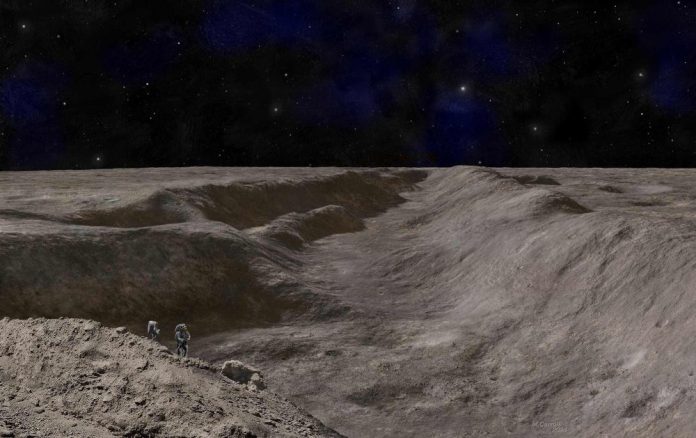
Our Moon continues to surprise us with amazing features.
Scientists recently shared new information about two canyons that branch out from a major lunar impact.
The site is the Schrödinger basin near the Moon’s South Pole.
It formed when an asteroid or possibly even a leftover planetesimal slammed into the surface. It took only minutes to dig out that huge crater and split the landscape to make two huge rifts that extend from the site.
According to David Kring of the Lunar and Planetary Institute in Houston, TX, the impact is of very ancient origin.
“Nearly four billion years ago,” he said, “an asteroid or comet flew over the lunar south pole, brushed by the mountain summits of Malapert and Mouton, and hit the lunar surface.
The impact ejected high-energy streams of rock that carved two canyons that rival the size of Earth’s Grand Canyon. While the Grand Canyon took millions of years to form, the two grand canyons on the Moon were carved in less than 10 minutes.”
Those two canyons—named Vallis Schrödinger and Vallis Planck—are significant clues to that turbulent time in the Moon’s past. And, they’re impressive. Vallis Schrödinger is just under 300 kilometers long, 20 km wide, and 2.7 kilometers deep.
Vallis Planck has two units. One is a deep canyon within the ejecta blanket of debris thrown out by the impact. The rest comprises a row of craters made as falling rocks were thrown out from the impact. They fell back to the Moon to create so-called “secondary craters.”
The canyon part is about 280 kilometers deep, 27 km wide, and 3.5 km deep. The depth of both of these canyons surpasses the deep gorges of Earth’s Grand Canyon in Arizona.
Anatomy of an Impact and its Aftermath
The impactor probably slammed into the surface at nearly 55,000 kilometers per hour. The crash is what produced the enormous 320-kilometer-diameter Schrödinger impact basin. In the aftermath, the rocky debris scoured the deep canyons.
Schrödinger formed in the outer margin of the South Pole-Aitken (SPA) basin. At a diameter of about 2,400 km, it’s the largest and oldest impact basin on the Moon. The basin’s rim is about 300 km from the South Pole and within 125 km of the proposed exploration site for the Artemis mission.
The Schrödinger crater has a ~150-km diameter peak ring and the whole area is surrounded by a blanket of impact ejecta that splashed out in an irregular pattern up to 500 km away. The outermost crater ring resembles a circular mountain range and rises 1 to 2.5 km above the basin floor. It was produced by the collapse of a central uplift after the impact.
After the impact, basaltic lava flows flooded the area. A large pyroclastic vent erupted more material onto the basin floor. That volcanic activity ended around 3.7 billion years ago.
Impact Anomalies
A careful analysis of the impact basin the canyons, and the ejecta surrounding the site by Kring and a team of scientists at the Lunar Planetary Laboratory, gives an idea of impact details. In a paper released about the site, the scientists discuss its features, plus some unusual finds.
For example, the canyon rays don’t converge at the basin’s center as you might expect from typical impacts. They seem to come together in a different spot. That implies a point explosion impact.
The location of the converging rays suggests that the incoming asteroid’s trajectory was about 33.5 west of north.
The evidence also points to a distributed impact. That could mean the impactor came in at a low angle. Or, it’s also possible that secondary ejecta from the impact also came in at low angles.
There are many secondary craters in the area which help explain the possibilities. Continued analysis will help explain the huge amounts of energy released in the event. Gareth Collins, one of Kring’s team members, said, “The Schrödinger crater is similar in many regards to the dino-killing Chicxulub crater on Earth. By showing how Schrödinger’s km-deep canyons formed, this work has helped to illuminate how energetic the ejecta from these impacts can be.”
Future Exploration
Of course, these rays and the impact basin will end up as great exploration points for NASA’s upcoming Artemis missions. Right now, the evidence from the ejecta blanket points to the fact that there’s an uneven distribution, particularly in the area where the first missions are planned. That will allow astronauts and robotic probes to reach underlying samples of the Moon’s primordial crust without having to dig through rocks of a younger age.
Since the basin is the second-youngest basin on the Moon, the impact melted rocks will be a great way to test the actual age of the impact. The general understanding is that some 3.8 billion years ago, the Moon (and Earth) experienced a great many of these collisions. This epoch was the Late Heavy Bombardment, thought to have lasted up to 200 million years.
The continual impacts during this time scarred the surfaces of the rocky planets and the Moon, as well as asteroids. Lunar rocks created as a result of lava flows at that time will open a window into their ages and mineralogy, especially compared to other, older rock formations.
They should also improve our understanding of that period of solar system history. In particular, it can help scientists characterize the impacts on Earth that affected not just the surface, but its life forms.
Written by Carolyn Collins Petersen/Universe Today.



